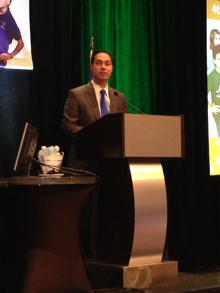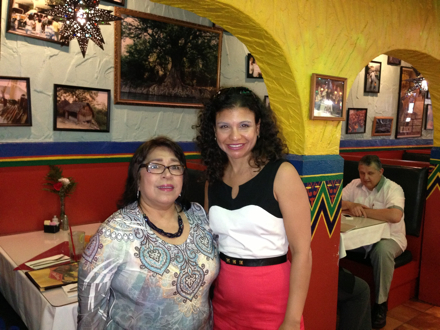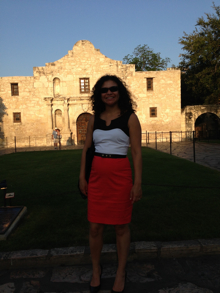Creating Healthier Communities: My Time in San Antonio and the Salud America! Summit
Photos from left to right: From rolling out bike stations to increasing the number of salad bars in schools, San Antonio Mayor Julián Castro's Administration has made public health a top priority; a photo of a bike station in San Antonio -- something I have never seen anywhere else.


SAN ANTONIO, Texas -- I just got back from the 4th annual Salud America! Latino health summit. Researchers, policy analysts, public health advocates and elected leaders gathered to discuss the most pressing health concerns facing the U.S. Latino community.
Once under the auspice of "childhood obesity", grassroots activists and researchers painted a much broader and more complex picture: many of the health challenges facing the Latino community is systemic and environmental. We must implement policies that bring physical education back to schools; build parks and bike lanes to promote outdoor activity; make sure that all communities have access to fresh produce; and curb junk food marketing to children -- which is increasingly becoming digital and harder for parents to monitor on their own.
"Don't reduce obesity to a disease that needs to be cured," said Dr. George Flores, program manager for The California Endowment's Healthy California Prevention team. "It's an opportunity for equity."
Photo on right: Here is a man who takes public health very seriously: New York Assemblyman Félix Ortiz. From the time he was a child and circulated his first public petition asking the Governor of his native Puerto Rico to support the formation of a youth baseball league, he has successfully helped draft and implement public health policies in New York: the first law in New York -- and the country! -- to prohibit hand-held cell phones while driving; a law that provides farmers with economic relief by requiring schools to purchase locally grown produce; a law to ensure that nutritionally based education programs be a part of every classroom; and a law to create five eating disorder centers across the state to help those who suffer from eating disorders like bulimia and anorexia.
Latinos are the largest minority group in the country, accounting for 50.5 million people in 2010. "The increasing presence of Latinos in the United States will impact all institutions," said Dr. Rogelio Sáenz, Dean of the College of Public Policy at the University of Texas at San Antonio.
I was heartened by the promising statistics and stories that came out of the summit. The high school dropout rate among Latinos in the last 10 years has been cut in half and Latino youth are going to college at a faster rate than even their Caucasian counterparts. The Latina teen pregnancy rate and fertility rate, in general, has dropped with upward mobility.
In terms of health epidemics facing the community, such as type 2 diabetes and heart disease, there is a lot of grassroots energy on the ground to turn this around. Latino elected officials with the help of their constituents are helping transform "food deserts" and neighborhoods dotted by crime and blight into healthy-living hubs. Latino youth and parents especially are empowered and demanding that healthy food options be available in their local supermarkets and schools.
Photo on left: Dr. Amelie G. Ramirez, Director of Salud America! and Professor of Epidemiology and Biostatistics at the University of Texas Health Science Center at San Antonio, has moved mountains in the area of Latino health. All the research, the amazing speakers we got to network with and the summit could not have happened without her. Photo on right: Paul Lopez, a Denver City Council member and a member of the board of the National Association of Latino Elected and Appointed Officials (NALEO), gave an inspiring presentation with "before" and "after" pictures of his childhood neighborhood, which now has a grocery store, community gardens at its schools, and soon, a park.


On a personal note, it was my first time in San Antonio and I fell in love with the city. What is a health conference without downtime to explore the great outdoors? Enjoy!
Photo: The outside space of the South Texas Heritage Center at the Witte Museum is lush and beautiful. In general, I was pleasantly surprised at how much green space San Antonio had -- not at all what I expected with the punishing heat.

Photos: My friend Elsa took me to Mi Tierra, a Mexican restaurant in the market and hands-down the best place I've eaten chicken enchiladas verdes. I loved the decor of the restaurant, too, especially the mural of Latino leaders and celebrities.




Photo: And how could I visit San Antonio without stopping at the Alamo?




The views and opinions expressed in this post are those of the author(s) and do not necessarily reflect those of MomsRising.org.
MomsRising.org strongly encourages our readers to post comments in response to blog posts. We value diversity of opinions and perspectives. Our goals for this space are to be educational, thought-provoking, and respectful. So we actively moderate comments and we reserve the right to edit or remove comments that undermine these goals. Thanks!